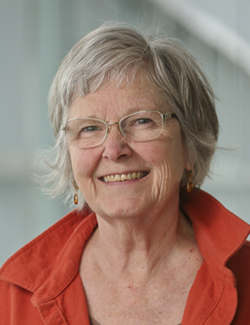Dagmar Ringe
 Professor of Biochemistry and Chemistry Emerita
Professor of Biochemistry and Chemistry Emerita
Professor Ringe is retired. Her lab is now closed.
Degrees
Boston University, PhD
Profile
Our interests were generally in the relationship of protein three-dimensional structure to chemical function. To this end, research was focussed on the modification of the catalytic properties of a number of pharmaceutically or industrially important enzymes. The methods used were a combination of X-ray crystallography, design of transition-state analog inhibitors, and site-directed mutagenesis. The objectives were to learn how to re-engineer these catalysts to perform useful chemical reactions which may not occur efficiently with the naturally occurring enzyme, to dissect the individual steps in a mechanism and characterize them structurally, or to learn how to inhibit an enzyme specifically and selectively.
The proteins that were studied included enzymes utilizing pyridoxal phosphate as cofactor, a GTP-binding protein, a DNA-binding protein, and several proteases. Different methods were used to study these systems, including traditional kinetic and structural methods, and low-temperature and time-resolved x-ray structural methods. In addition, a new method for the mapping of binding surfaces on proteins was developed for the design of specific inhibitors.
The expression of diphtheria toxin in toxigenic Corynebacterium diphtheria is controlled by a transition metal ion activated repressor DtxR. The repressor binds DNA after activation by the metal ion and thereby regulates expression of the toxin. The mechanism of activation was studied structurally. Pyridoxal is capable of catalyzing several types of transformations. However, any one enzyme utilizing this cofactor does only one of them predominantly. The question therefore arises how the protein controls the chemical outcome of such transformations. We studied a number of these enzymes structurally in order to begin to answer that question.
Serine proteases are important in cellular development, blood clotting, and a variety of defense mechanisms. Disorders involving these proteases are often linked to the absence or inefficiency of a specific inhibitor to control the activity of the enzyme. The design of such inhibitors requires detailed knowledge of the structure of the enzyme, of the enzyme complexed with inhibitors, and if possible, an understanding of the mechanisms of inhibition.
Selected Publications
Deshpande AR, Wagenpfeil K, Pochapsky TC, Petsko GA, Ringe D. “Metal-dependent function of a mammalian acireductone dioxygenase” Biochemistry 55, 1398-407 (2016).
Wu R, Sanishvilli R, Belitsky BR, Juncosa JI, Le HV, Lehrer HJS, Farley M, Silverman RB, Petsko GA, Ringe D, Liu D, “PLP and GABAtrigger GabR-mediated transcription regulation in Bacillus subtilis via external aldimine formation” Proc. Natl. Acad. Sci. USA (2016) in press
Wang W, Nguyen LTT, Burlak C, Chegini F, Guo F, Chataway T, Ju S, Fisher O, Miller DW, Datta D, Wu F, Wu C-X, Landeru A, Wells JA, Cookson MR, Boxer MB, Thomas CJ, Wei PG, Ringe D, Petsko GA, Hoang QQ. “Caspase-1 causes truncation and aggregation of the Parkinson’s disease-associated protein α-synuclein.” Proc. Natl. Acad. Sci. USA 113, 9587– 9592 (2016).
Bassil F, Fernagut P-O, Bezard E, Hoang QQ, Ringe D, Petsko GA, Meissner WG. “Reducing C-terminal truncation mitigates synucleinopathy and neurodegeneration in a transgenic model of multiple system atrophy.” Proc. Natl. Acad. Sci. USA 113, 9593 – 9598 (2016).
Kim CH, Han BS, Moon J, Kim DJ, Shin J, Rajan S, Nguyen QT, Sohn M, Kim WG, Han M, Jeong I, Kim KS, Lee EH, Tu Y, Naffin-Olivos JL, Park CH, Ringe D, Yoon HS, Petsko GA, Kim KS. "Nuclear receptor Nurr1 agonists enhance its dual functions and improve behavioral deficits in an animal model of Parkinson's disease." Proc Natl Acad Sci U S A. 2015 Jul 14;112(28):8756-61.
Barmada SJ, Ju S, Arjun A, Batarse A, Archbold HC, Peisach D, Li X, Zhang Y, Tank EM, Qiu H, Huang EJ, Ringe D, Petsko GA, Finkbeiner S. "Amelioration of toxicity in neuronal models of amyotrophic lateral sclerosis by hUPF1." Proc Natl Acad Sci U S A. 2015 Jun 23;112(25):7821-6.
Prediction of distal residue participation in enzyme catalysis. Brodkin HR, DeLateur NA, Somarowthu S, Mills CL, Novak WR, Beuning PJ, Ringe D, Ondrechen MJ. Protein Sci. 2015 May;24(5):762-78.